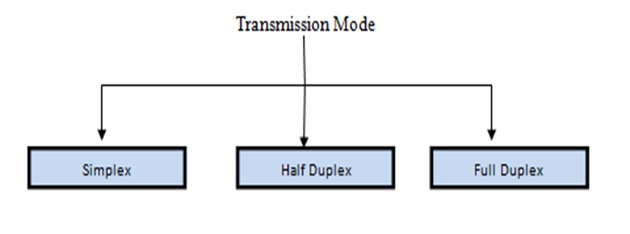Home »
Computer Network
Transmission Modes in Computer Network
Computer Network | Line Configuration: In this tutorial, we will learn about the transmission modes in Computer Networking. We will also discuss the Types of Transmission Modes and illustrate it with the help of its diagram.
By Monika Jha Last updated : May 04, 2023
What are Transmission Modes in Computer Network?
The mechanism of transferring data or information between two linked devices connected over a network is referred to as Transmission Modes.
- The transmission mode is also called as the communication mode.
- It tells the direction of signal flow between the two linked devices.
- Buses and networks are designed to allow communication to occur between individual devices that are linked over a network.
Categories of Transaction Modes
There are three categories of transmission mode:
- Simplex Mode
- Half-Duplex Mode
- Full-Duplex Mode

1. Simplex Mode
- In this type of transmission mode, communication is unidirectional that is data can be sent only in one direction. This means you cannot send a message back to the sender just like a one-way street.
- From the two devices, only one can send or transmit on a link and the other can only receive the data.

Simplex Mode of Transmission
Example
- A simplex duplex transmission can be seen between a computer and a keyboard. A television broadcast, television and remote are also examples of simplex duplex transmission.
- Another example of simplex transmission includes a loudspeaker system. An announcer sends his/her voice into a microphone and voice is sent through an amplifier and then to all the speakers.
Advantage of Simplex mode
In this mode, the station can utilize the entire capacity of the communication channel, so there can be transmitted more data at a time.
Disadvantage of Simplex mode
Mainly communications require the two-way exchange of data but it is unidirectional, so it has no inter-communication between devices.
2. Half-Duplex Mode
- In a Half-duplex mode, each station can transmit and receive the data as well.
- The flow of messages can be in both directions, but not simultaneously.
- The entire capacity (bandwidth) of the communication channel is utilized in one direction at a time.
- In half-duplex mode, the sender sends data and wait for its acknowledgment and if there is any error so that receiver can demand it to retransmit that data. By this error detection is possible.
An example of half-duplex mode is Walkie-talkie. In Walkie-talkie, from one side a speaker speaks, and from the other side, someone listens. After a pause, the other speaks and first-person listens.

Half- Duplex Mode of Transmission
Example
This is like a one land road with two-directional traffic. While cars are traveling in one direction, cars going to another way must wait.
Advantage of Half-duplex mode
In half-duplex mode, the entire capacity of a channel is taken over by whichever of the two devices is transmitting at the same time.
Disadvantage of Half-Duplex mode
It causes the delay in sending the data at the correct time as when one device is sending the data, then another has to wait to send data.
3. Full Duplex Mode
- In Full duplex mode, the communication is bi-directional, i.e., the data flow in both the directions at the same time.
- From both the ends receipt and transmission of data is possible at the same time.
- Full-duplex mode has two physically separate transmission paths, one is for traffic moving in one direction, and another path is for traffic moving in the opposite direction.
- It is one of the fastest mode of communication between devices.

Full- Duplex Mode of Transmission
Example
On a telephone line, two people are communicating with each other both can talk and listen to each other at the same time, this is the full-duplex transmission.
Another example includes a two way street with traffic flowing in both the directions simultaneously.
Advantage of Full-duplex mode
Both the stations can send and receive the data at the same time, so the capacity of link can be shared.
Disadvantage of Full-duplex mode
The bandwidth of the communication channel is divided into two parts if there is no dedicated path exists between the devices.
Advertisement
Advertisement